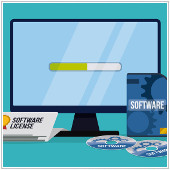 Whether you only need a dozen, or a hundred, the process of deciding on and acquiring software licenses can be very frustrating. Many of us had hoped that cloud computing and virtualization would alleviate some of these headaches. Unfortunately, we’re not there yet, which is why it’s important to understand all of your licensing options when deciding on a virtualized environment — let’s take a look.
Whether you only need a dozen, or a hundred, the process of deciding on and acquiring software licenses can be very frustrating. Many of us had hoped that cloud computing and virtualization would alleviate some of these headaches. Unfortunately, we’re not there yet, which is why it’s important to understand all of your licensing options when deciding on a virtualized environment — let’s take a look.
Why are licenses an issue?
Virtualization is a complex topic, so let’s have a quick review. Most people are starting to work the concept of cloud storage into their everyday lives. Think of virtualization as a cloud where your server(s) store their hardware capabilities and your network computers can pull from that cloud as needed.
In this scenario, let’s assume employee A and employee B have two identical desktop computers with barebones hardware. Employee A needs to perform some basic text editing while employee B needs an in-depth scan of your client database. With the right infrastructure management, both employees will connect to your business’ server for the necessary physical processing power and server-hosted software. That means employee A will request the appropriate amount of processing power to edit text (which is likely very little) from the server, while employee B requests a much larger chunk of RAM, processing and harddrive space for scanning the database.
Understand so far? Because it gets really tricky when we start asking how many licenses are required for the server-hosted software. Licensing models were originally based on the number of physical hard drives with installed copies. However, in a virtualized environment that’s not an accurate reflection of usage. Using the most recent platforms, administrators can divide up their CPU into as many virtual machines as the SMB requires.
What do current virtualized licensing models look like?
Sadly, the virtualization and software industries are still deciding what’s the best way to move forward. The very vendors that sell the software required to manage the creation of virtual machines and segmentation of your server disagree about which model to use.
The company behind the popular VMware software has switched to a per-virtual-machine model after a huge response from customers, while other powerhouse vendors like Oracle and Microsoft have stuck with the per-CPU-core model that is based on server hardware capacity.
In any software selection process there is almost always the option of open source software. Under the open source model there are no licenses and usage is free, and just last month, AT&T committed to virtualizing 75 percent of its office under the OpenStack cloud computing platform by 2020.
What should I do?
In the end, software license considerations and total cost of ownership calculations should be a huge factor in how you plan to virtualize your SMB. When discussing the possibility of an infrastructure migration with your IT services provider, make sure to ask about the advantages and disadvantages of different virtualization platforms compared with their licensing models. You may find that paying more for hardware-based models is worth it, or that open source platforms provide you with everything you need.
No matter which platform you choose, remember to list every piece of licensed software in your office. Find out which licenses you can keep, which ones you’ll need to update and most importantly what the license migration will cost you in the short and long run.
This might seem like too much to handle at first. The process of virtualizing your SMB alone is enough to have you reaching for the aspirin. By contacting us you can avoid the headache entirely; we’ll walk you through all of the steps necessary to guide your organization through this next step in modernizing your business model.